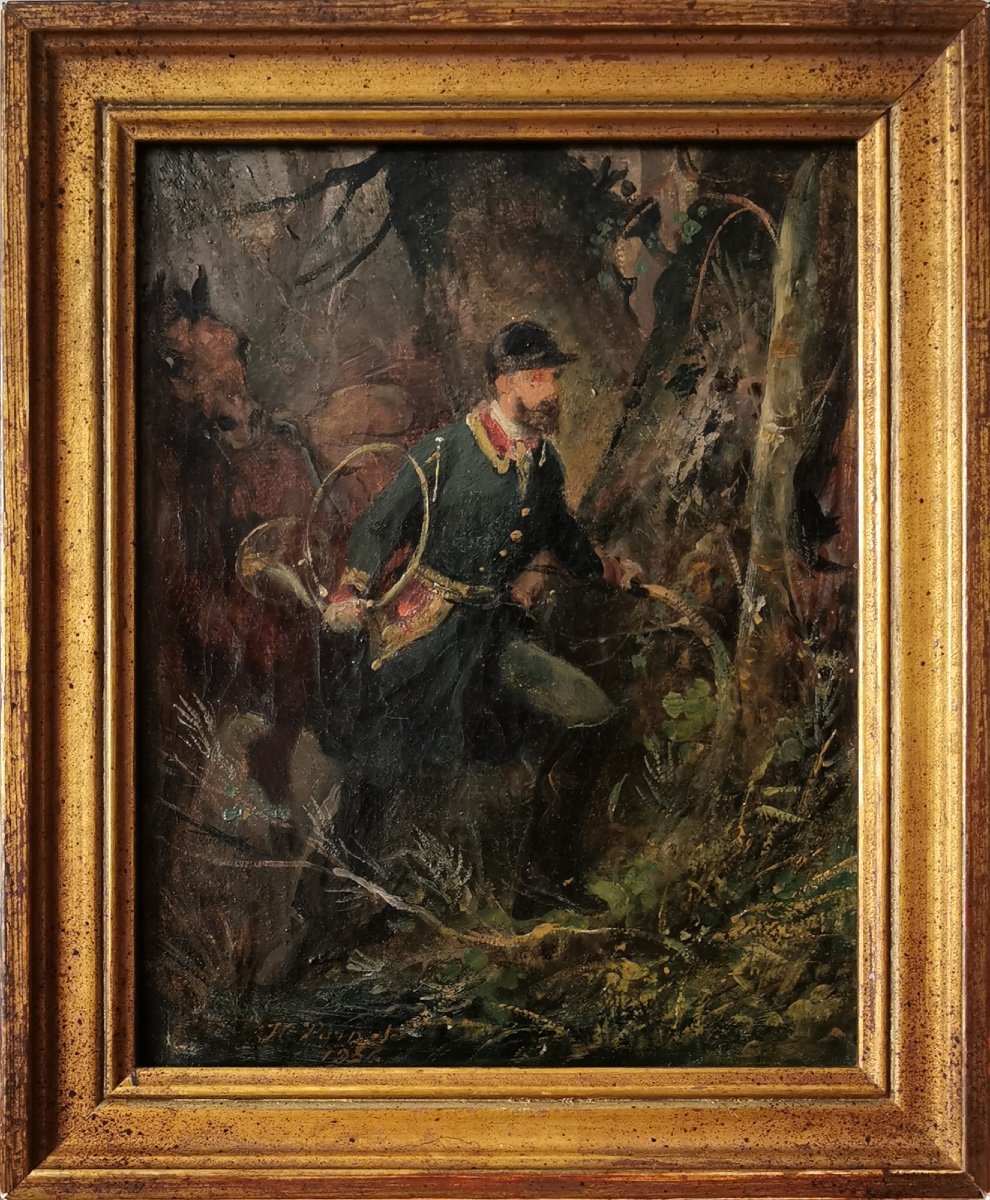Hunting scene, exploratory walk in the forest by a ringer and his horse, Italian period of Vernet, Marais Pontins
Oil on canvas, signed and dated lower left 1832 On sight: 17.8 cm x 14 cm – framed: 22.7 cm x 18.8 cm
Gilded wood frame
Probable preparatory study for the major works “Hunting in the Pontine Marshes” and “View in the Nettuno Forest (former title)” appearing in the Washington collections National Gallery of Art Annotation on the back of the painting in pencil: Vernet sale 1911
Our painting, oil on canvas signed by Vernet and dated 1832, probable preparatory study, is to be compared with the diptych by Horace Vernet appearing in the collections of the National Gallery of Art in Washington; two masterpieces by the master dated 1833, in a spectacular format exceeding one metre, both produced a year after this compact sketch. Works exhibited under the titles: “Hunting in the Pontine Marshes, 1833” and “Departure for the Hunt in Pontine Marshes, 1833”. In addition to the subject, the proximity of the dating, the same romantic expressiveness brings together these three works from the Italian and Roman periods of Horace Vernet. At the heart of these two Washington masterpieces, a forest so impressive that the hunters who travel through it seem to disappear, as if swallowed up by this almost supernatural natural setting. Works produced while Horace Vernet directed the French Academy in Rome, a position he held from 1829 to 1834. Two works which belonged to Pierre-Hippolyte Aumont in 1846 until his death. They were then dispersed in the sale of May 6, 1870 (expert Francis Petit) entitled “Collection of modern paintings among which are 10 paintings and 6 studies by Horace Vernet”; these were lots 4 (“Hunting in the Pontine Marshes”, 99 cm x 1.35m) and 5. (“View in the Nettuno Forest” (99cm x 1.25m). “Hunting in the Pontine Marshes” (Hunting in the Pontine Marshes) was exhibited at the Bazar Bonne Nouvelle for the benefit of the association of artists, painters and sculptors in 1946, then during the Tokyo Metropolitan Art Museum exhibition presenting the Museum's masterpieces in 1999 of Washington. In 2003, the work was loaned to the Tate Britain as part of the exhibition "Constable to Delacroix". It is likely that our painting served as a preparatory study for the creation of this monumental diptych of inspiration romantic, where nature, the lush setting of the Pontine Marshes, then an inextricable jungle to tame despite its mephitic vapors, forms the preponderant subject to the voluntary detriment of man and the equines so fond of Vernet father (Carle) and son ( Horace). This painting, a dazzling summary of mastery, thus offers a precious and intimate point of view on these two grandiose works of 1833; two powerful and rare animated landscapes in the often martial work of Horace Vernet, a master so admired in his time and remaining highly rated. Here, a bell ringer, a finely drawn rider in his hunting costume, carrying his hunting horn as it should, precedes his horse, to make a path in a dense forest which already captures all the attention. Captured in a very lively scene, the character in his hunting outfit, wearing riding boots, steps over a tree trunk lying on the ground and holds on to a branch. Around him, everything is luxuriance, he remains vigilant. His horse, standing back, seems just like him to be on the lookout. Beyond the hide, a condition for hunting, the place, infested with bandits since Antiquity, but also conducive to malaria, could prove dangerous. Caesar was the first to want to clean up this region of Latium by diverting the Tiber towards the marshes. However, he died before he could carry it out. The project was resumed in 1899 but was not carried out until 1828 by Mussolini, who made the Marshes cultivable. In 1832, Horace Vernet especially projected in this swampy forest, with the air of ancient Guyana, all the pictorial audacity. The handwritten annotation on the back of our painting refers to a Vernet sale in 1911. It could have been the Haro estate and December 12-13, 1911, but after consultation it is probably another cataloged sale, transaction or donation. The Gustave Vermeersch collection had been the subject of a large bequest in 1911 and contained drawings by Horace Vernet but no paintings. It is difficult to reconstruct the course of our painting since 1832. Perhaps it had not left the master's collection. Its link with the masterpieces of Washington, on the other hand, appears stylistically and chronologically manifest.
To discover on the website of our gallery WE ART TOGETHER






















 Le Magazine de PROANTIC
Le Magazine de PROANTIC TRÉSORS Magazine
TRÉSORS Magazine Rivista Artiquariato
Rivista Artiquariato
